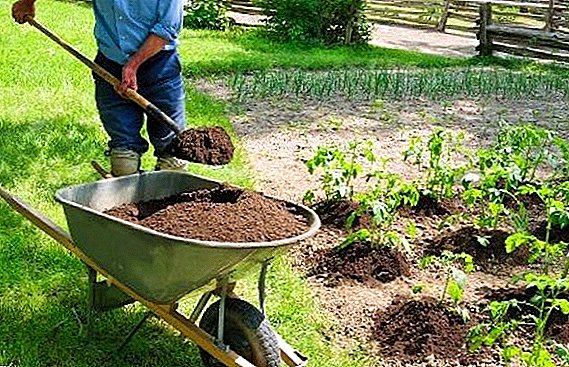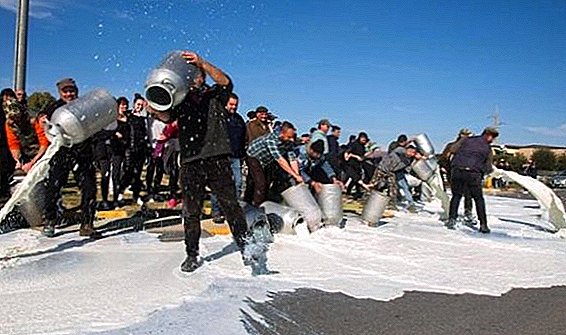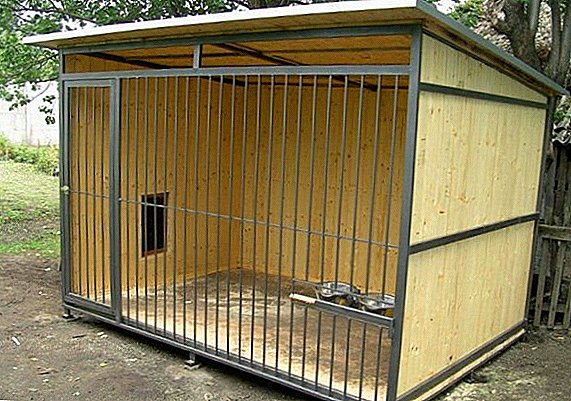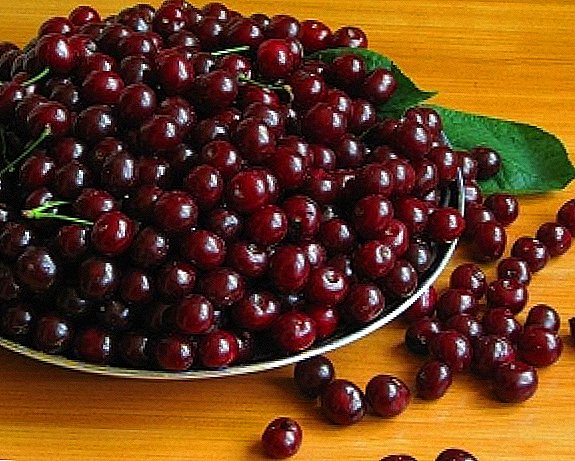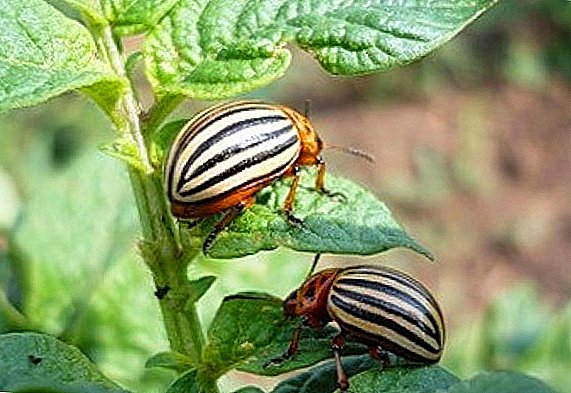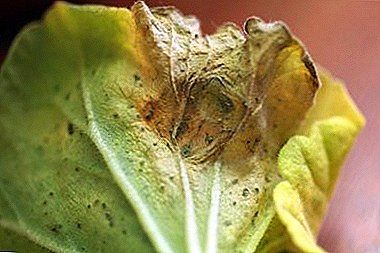
Pelargonium, and in other words, geranium is one of the most popular indoor plants.
Diseases and various pests can slow down the development of a beautiful flower or even completely destroy it.
The article will discuss the description of plant diseases and parasites, as well as the prevention and control of them at home.
Description of diseases and parasites with photos
Consider in detail the description of diseases and pests, as well as look at them in the photo.
Common diseases, diagnosis, treatment
Geranium is prone to various kinds of diseases.
Mushroom Botrytis
Diagnose this disease is easy. Flower with the appearance of the fungus is covered with gray spots and down. Brown areas can be observed on the stems. On them most often occurs rotting, which passes to the leaves, after which they fall.
Reference! The cause of the fungus is a surplus of moisture.
Treatment - loosening and cleaning the soil from weeds and dead plant areas, removing the affected flower, chemical treatment with fungicides.
In order to better absorb moisture and drying out the soil, it is advisable to water the geranium in the morning.
Root rot
To root rot causes fungal infection. In this case, the sheet plates turn yellow and then turn brown or black in places. The flower is covered with a bright touch like a spider's web.
Treatment - soil loosening, elimination of fertilizers with a high nitrogen content, removal of diseased stems and foliage, use of fungicides for weeping soils.
Leaf rust
Signs of rust - the appearance of rust-yellow areas on the leaves. When fully defeated, the plant becomes sluggish and begins to crumble. In disrepair, the flower rots and turns black.
Treatment - removal of weeds and dead fragments, lower watering, the use of fungicides.
Bacterial disease
Germs provoke disease. The disease can be diagnosed by brown spots in the shape of a triangle. The affected areas begin to dry, and the plant fades.
Treatment - cleaning or complete replacement (flower transplant) of the soil, watering up to round 11, the use of fungicides.
Viral infections
Symptoms of viral diseases can occur, ranging from cessation of growth and ending with the appearance of brown-purple circular spots.
Treatment is similar to the treatment of a bacterial disease, but special attention should be paid to pests - carriers of infection.
Spotting (Alternaria)
Bubbles and spots appear on the underside of the sheet. As a result, the leaf becomes sluggish, begins to turn yellow, and then fall off.
Leaf spotting may be a symptom of another disease - chalcosporosis.. In this case, hollow pale areas appear on the leaves, which later acquire a gray tint.
Treatment - removal of all affected leaflets, thinning processes and treatment with fungicides.
Edema
On the leaves appear bubbles filled with liquid. At first light green color, and then get a brown shade.
Reference! The cause of edema is a surplus of moisture and low air and soil temperature.
Treatment - the creation of optimal conditions for growth.
Chlorosis
Failure in the process of photosynthesis occurs due to the lack of mineral supplements. The leaves begin to change color. If the leaves brighten the rim is a lack of nitrogen. With a sulfur deficiency, the whole plant turns yellow evenly. If the room beauty is not enough magnesium, then stains appear between the streaks of old leaves.
The lack of phosphorus is indicated by the yellow spot on the old leaves near the petiole, which then spreads over the whole leaf.
Treatment - regular feeding with balanced complex fertilizer or a specific substance.
Bacterial burn
Dried areas are twisted and deformed.. Pelargonium stops development. Details about why pelargonium folded, dried or redden leaves and what to do, you can find out.
Treatment is useless. Sick plant should be disposed of.
Dropsy
Abnormal conditions of detention lead to a physiological malady. - overflow, cold and high humidity. On the underside of the leaves with dropsy you can find swollen swollen areas.
Treatment - reducing irrigation, improving drainage, warm ventilated room.
Ring spots
Light ring-shaped spots on the leaves are evidence of ring spots. As a result of the disease, infected leaf plates are folded inward or sag by umbrellas.
Healing - destroy all leaveswhich are twisted or stained, treat the plant with fungicides.
Mealy dew
The main symptom of this fungal infection is white powdered plaque on the leaves.
Treatment - removal of all infected leaves, treatment with fungicides or colloidal sulfur.
Blackleg
This fungal disease affects the stem.. First, a dark spot appears at the soil level, then black rot quickly grows.
The appearance of a black stalk in a flower is provoked by too heavy soil, overflow and poor drainage.
Treatment is useless.
Late blight
When late blight leaves wither and coagulate, or neither of them and the stalk appear dark hollow spots.
Treatment - usually this disease is diagnosed in the latter stages, when treatment is already useless. If a small area is infected, it is necessary to remove it and transplant the flower into a new substrate. For prevention and treatment use:
- "Ridomil".
- "Profit Gold".
- "Previkur".

Yellowing leaves
If only the edges of the leaves turn yellow, it is necessary to increase the amount of watering. The lack of moisture is the main cause of this disease. But if, against the background of yellowing, a general weakness of the plant is observed, then watering, on the contrary, should be reduced.
Reference! Only the lower leaves turn yellow with a lack of lighting.
Yellowed leaves after transplantation - a natural side effect. Yellow areas need to be removed, and the flower will continue to develop.
We offer to watch a useful video about yellowing of leaves in pelargonium.
No flowering
Possible reasons:
- low temperature;
- lack of lighting;
- excess fertilizer;
- lack of nutrients in the soil;
- too big flower pot;
- the absence or lack of pruning (how to properly pinch and trim the pelargonium?).

More about what to do if pelargonium does not bloom, read our material.
Why do buds dry?
Sometimes peduncles without blooming, wither and dry. The reason for this is usually in the deficiency of trace elements, in particular - phosphorus.
It is also sometimes necessary to replant the flower in fresh soil (for details on how to choose the soil and pot for planting pelargonium, read here, and from this article you will learn about the features of planting and transplanting pelargonium).
Pelargonium can also dry its buds because of a lack of boron, as well as improper watering. Watering is necessary regularly, but moderately.so that the soil has time to dry. The reason that the buds have started to dry can be heat and dry air. Pelargonium, which fights disease or pests, will not have the strength to bloom.
Treatment - extra feeding, moderate watering, creating the optimum temperature - 15-20 degrees.
Overfeeding is also harmful. Abuse of nitrogen will lead to the fact that the plant will increase more greenery, but will not bloom.
Fire breakers and how to deal with them?
Pests not only weaken pelargonium by eating certain areas, but also provoke the appearance of infectious diseases, therefore, they must be fought with.
Aphid
Aphids drink the juice of geraniums, as a result of which the leaves curl and dry around the plant. Pests multiply rapidly. The affected areas must be removed and the flower treated with "Fitoverm" or "Mospilan".
White fly
White midges often affect royal varieties. Leaves with parasites need to be removed., and the plant is watered three times with "Aktar" at intervals of a week.
We offer to watch a useful video on how to deal with the whitefly.
Spider mite
A sign of the appearance of this parasite - strings of cobwebs and small white dots on the leaves. Leaves can also curl inside. Spider mite often suffers from infectious diseases of pelargonium. Infected leaves should be removed. To combat pest apply:
- "Akarin".
- "Actellic".
- "Fitoverm".

Termites
The flower must be sprayed with aspirin every other day. (1 tablet per 8 l). Also for the prevention of these parasites and treatment, you can use the "Messenger" and "Marathon".
Nematode
The smallest and very dangerous worms eat roots from the inside, as a result characteristic nodes appear on them. In this case, the treatment is useless, the plant and the soil should be destroyed.
Rootbird
The oval whitish insect usually appears in overmoistened soil. The parasite eats roots and geranium ceases to develop. With a small lesion, the ground is washed off from the roots and the damaged areas are cut off. A new primer for prophylaxis is treated with Vidat or Tekta. It is recommended to water Aktara.
Mealybug
This pest hides under white sticky clots and drinks the sap of the plant. Parasites clean with a damp clothand then sprayed the room darling with a solution of alcohol and soap (20 g of soap and 20 ml of alcohol per 1 liter of hot water). For serious infections use:
- "Aktaru".
- "Actellic".
- "Fufanon".

Slugs
The slug eats the leaves of pelargonium, leaving holes in them. If manual collection of pests does not help, then use drugs:
- "Thunderstorm".
- "Ferramol".
- "Slyneed".

What if all geraniums are affected?
Wet, cool earth - these are ideal conditions for the development of fungal diseases. They provoke root rot and rot of the root neck of pelargonium. In this case, the geranium can not be saved. It remains only to cut the stalk from the healthy part of the flower and re-grow the peralgonium (how to propagate pelargonium by cuttings?).
Prevention and care at home
Basically, all the ills of a houseplant arise because of violations in the care (about the features of caring for pelargonium at home, read here). Pelargonium vital fresh air. Ventilate the room regularly. This is the prevention of fungal diseases. Observe a comfortable temperature regime, control the lighting and humidity of the soil and air. Periodically feed the soil and inspect the plant for the appearance of parasites.
Geranium falls ill if left untreated or as a result of a fungus, bacterium or virus. Water the indoor beauty, avoiding overflowing and drying, do not forget to feed the plant in a timely manner, provide proper lighting and regular ventilation of the room - and then pelargonium will delight its beauty for a long time (how to water and how to feed pelargonium?).
We offer you to watch a video about Pelargonium pests:


